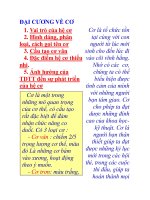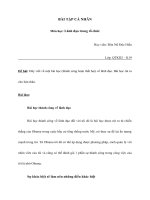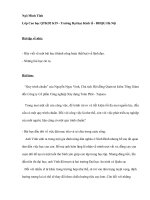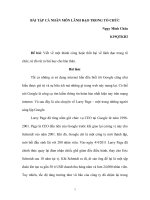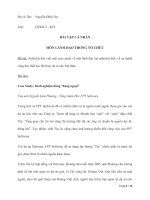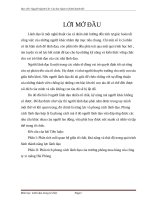Slide đại cương về lãnh đạo trong tổ chức 7 8 strategic leadership and managing crises and change
Bạn đang xem bản rút gọn của tài liệu. Xem và tải ngay bản đầy đủ của tài liệu tại đây (2.77 MB, 59 trang )
LEADERSHIP:
ng
.c
om
Theory, Application, Skill
Development
co
2d Edition
ng
th
an
Robert N. Lussier
and Christopher F. Achua
du
o
This presentation edited and enhanced by:
cu
u
George W. Crawford
Asst. Prof. of Mgmt.
Clayton College & State University
Morrow, GA 30260
11-1
Copyright ©2004 by South-Western, a division of Thomson Learning. All rights reserved.
CuuDuongThanCong.com
/>
ng
.c
om
Chapter 11
cu
u
du
o
ng
th
an
co
Strategic Leadership and
Managing Crises and Change
11-2
Copyright ©2004 by South-Western, a division of Thomson Learning. All rights reserved.
CuuDuongThanCong.com
/>
Chapter 11
Learning Outcomes
cu
u
du
o
ng
th
an
co
ng
.c
om
• Role of leadership in strategic management
process
• Relevance of internal and external environment
• Importance of a vision and mission statement
• Relationship between corporate objectives and
strategies
• Importance of strategy evaluation
• 5-step process to crisis risk assessment
• 3 phases of the change process
• Major reasons for resisting change
• People and task-oriented techniques for
overcoming resistance to change
11-3
Copyright ©2004 by South-Western, a division of Thomson Learning. All rights reserved.
CuuDuongThanCong.com
/>
STRATEGIC LEADERSHIP
cu
u
du
o
ng
th
an
co
ng
.c
om
• The process of providing the
direction and inspiration necessary
to create and implement a vision,
mission, and strategies to achieve
and sustain organizational
objectives
• The purpose of strategic leadership
is to effectively implement and
guide the process of strategic
management
11-4
Copyright ©2004 by South-Western, a division of Thomson Learning. All rights reserved.
CuuDuongThanCong.com
/>
ng
co
cu
u
du
o
ng
th
an
The set of decisions
and actions used to
formulate and
implement specific
strategies that
will achieve a
competitively superior
fit between the
organization and its
environment so as to
achieve organizational
goals
.c
om
STRATEGIC
MANAGEMENT
11-5
Copyright ©2004 by South-Western, a division of Thomson Learning. All rights reserved.
CuuDuongThanCong.com
/>
.c
om
The Strategic Leadership/
Management Process
• Analyze the environment
an
co
ng
– Internal (Why?)
– External (For What?)
th
• Develop a strategic vision
cu
u
du
o
ng
– An ambitious view of the future that
everyone in the organization can believe
in, that is reasonably attainable, and
which offers a future that is better in
important ways than what now exists
11-6
Copyright ©2004 by South-Western, a division of Thomson Learning. All rights reserved.
CuuDuongThanCong.com
/>
The Strategic Leadership/
Management Process
ng
.c
om
• Write a meaningful mission
statement
u
du
o
ng
th
an
co
– Defines the core purpose and
reasons for organizational
existence
– Should be both broad and precise
– Not easy
cu
• Can take months and years
– Must change as organization
changes
11-7
Copyright ©2004 by South-Western, a division of Thomson Learning. All rights reserved.
CuuDuongThanCong.com
/>
The Strategic Leadership/
Management Process
cu
u
du
o
ng
th
an
co
ng
.c
om
• Create Corporate Level Objectives
– Desired outcomes that an organization
seeks to achieve for stakeholders
– Include both financial and strategic
objectives
– Help everyone to focus in same
direction
– Targets against which performance is
compared
11-8
Copyright ©2004 by South-Western, a division of Thomson Learning. All rights reserved.
CuuDuongThanCong.com
/>
The Strategic Leadership/
Management Process
.c
om
SMART Corporate Level Objectives
co
ng
-Specific
cu
u
du
o
ng
th
an
-Measurable
-Achievable
-Relevant
-Timely
11-9
Copyright ©2004 by South-Western, a division of Thomson Learning. All rights reserved.
CuuDuongThanCong.com
/>
The Strategic Leadership/
Management Process
.c
om
Formulate Strategy
cu
u
du
o
ng
th
an
co
ng
Strategy is the general plan of
action that describes resource
allocation and other activities
for exploiting environmental
opportunities and helping the
organization attain its goals
11-10
Copyright ©2004 by South-Western, a division of Thomson Learning. All rights reserved.
CuuDuongThanCong.com
/>
.c
om
The Strategic Leadership/
Management Process
• Formulate Strategy that:
co
ng
– Enhances value to customers
an
• Ratio of benefits to cost
th
– Creates synergistic opportunities
du
o
ng
• Whole is greater than the sum of the
parts
cu
u
– Builds on company core competencies
ã Performs extremely well in comparison to
competitors
11-11
Copyright â2004 by South-Western, a division of Thomson Learning. All rights reserved.
CuuDuongThanCong.com
/>
.c
om
5 Elements of Good
Strategy Development
cu
u
du
o
ng
th
an
co
ng
• Arena: Where the organization will focus
its resources
• Vehicles: How the organization will get
there
• Differentiators: How the organization will
stand out in the market place
• Staging: What will be the speed and
sequence of moves
• Economic logic: How the organization will
obtain its returns
11-12
Copyright ©2004 by South-Western, a division of Thomson Learning. All rights reserved.
CuuDuongThanCong.com
/>
.c
om
The Strategic Leadership/
MGMT Implementation
co
ng
• Most difficult part of strategic
management
th
an
– Also the most important
du
o
ng
• Without appropriate implementation,
the best of strategies can fail
cu
u
– Must be integrated and coordinated
– Must overcome resistance to change
11-13
Copyright ©2004 by South-Western, a division of Thomson Learning. All rights reserved.
CuuDuongThanCong.com
/>
.c
om
Strategy Evaluation
th
an
co
ng
• To determine the effectiveness
of strategic choices
• 3 fundamental activities:
cu
u
du
o
ng
– Review internal and external
factors
– Measure performance against
objectives
– Corrective action
11-14
Copyright ©2004 by South-Western, a division of Thomson Learning. All rights reserved.
CuuDuongThanCong.com
/>
.c
om
Crisis Leadership
ng
• Leaders need skills and competence
to lead during crises
ng
th
an
co
– Like the U.S. and NYC on 9/11/01
– To provide stability, reassurance,
confidence, and a sense of control
cu
u
du
o
• “…tough times won’t create leaders, …
they show you what kind of leaders
you already have.” Larry Barton
11-15
Copyright ©2004 by South-Western, a division of Thomson Learning. All rights reserved.
CuuDuongThanCong.com
/>
Preparing for Crisis
.c
om
• We cannot foresee future crises, but
we can prepare in a general manner
ng
– Pre-Crisis Planning
th
– Crisis Team
an
co
• Do not want to start from zero when crisis
occurs
ng
• Good mix of organizational skill sets
u
Requires logs
Monitors complaints and behaviors
Identifies patterns or trends
Coordinates team activities
cu
ã
ã
ã
ã
du
o
Crisis Leader
11-16
Copyright â2004 by South-Western, a division of Thomson Learning. All rights reserved.
CuuDuongThanCong.com
/>
.c
om
Risk Assessment
ng
• Used to anticipate crises
co
– What could happen?
ng
th
an
• Tries to identify weaknesses and
threats
du
o
– Where are we vulnerable?
cu
u
• Common tool in crisis planning
– What is the worst-case scenario?
11-17
Copyright ©2004 by South-Western, a division of Thomson Learning. All rights reserved.
CuuDuongThanCong.com
/>
Risk Reduction Strategies
Crisis Prevention Simulations
du
o
4
ng
th
an
3
Risk Assessment & Ranking
ng
2
co
Risk
1 Identification
(Risk Chart)
.c
om
Risk Assessment Model
O
Crisis Management
11-18
Copyright ©2004 by South-Western, a division of Thomson Learning. All rights reserved.
CuuDuongThanCong.com
W
T
u
cu
5
S
/>
Crisis Management
cu
u
du
o
ng
co
ng
Effective Crisis
Communication
• Can make or break
company reputation
• Spokesperson
determined in precrisis planning
• Failure can extend
crisis
an
th
Leadership’s Role
• Stay engaged
• Lead from the
front
• Focus on the big
picture
• Communicate the
vision
• Work with crisis
management team
.c
om
Rapid response is vital
11-19
Copyright ©2004 by South-Western, a division of Thomson Learning. All rights reserved.
CuuDuongThanCong.com
/>
.c
om
Effective Crisis
Communications
ng
• First 24 hours crucial
ng
th
an
co
–Media’s need to know
–Tell company’s story
cu
u
du
o
ãPress releases
ãPress kits
11-20
Copyright â2004 by South-Western, a division of Thomson Learning. All rights reserved.
CuuDuongThanCong.com
/>
.c
om
Effective Crisis
Communication & Management
Be there
Tell the truth
Tell what your are doing to fix crisis
Handle those affected with utmost
sensitivity
• Avoid presenting conflicting messages
• Show a plan on how you plan to avoid a
repeat in the future
cu
u
du
o
ng
th
an
co
ng
ã
ã
ã
ã
11-21
Copyright â2004 by South-Western, a division of Thomson Learning. All rights reserved.
CuuDuongThanCong.com
/>
Effective Crisis
Communication & Management
co
ng
.c
om
• Don’t lie or cover for the boss or the
corporation
• Go the extra mile
an
– Beyond requirements of the situation
du
o
ng
th
• When things are going well, take
credit
– Without being self-absorbed
cu
u
• Remember that the media is your link
to the public
– Be honest & straightforward with them
11-22
Copyright ©2004 by South-Western, a division of Thomson Learning. All rights reserved.
CuuDuongThanCong.com
/>
• Organizational Change
.c
om
Leading Change
th
an
co
ng
– Activities associated with planning,
designing, implementing, and internalizing
tools, procedures, routines, processes, or
systems that will require people to perform
their jobs differently
cu
u
du
o
ng
• Organizations spend millions on change
efforts
• Organizational change is any transition
that requires change in human
performance
11-23
Copyright ©2004 by South-Western, a division of Thomson Learning. All rights reserved.
CuuDuongThanCong.com
/>
Need for Change
.c
om
• Environment changing rapidly
New technology
Globalize economy
Changing market requirements
Intense domestic and international
competition
– New opportunities and threats for
leadership
cu
u
du
o
ng
th
an
co
ng
–
–
–
–
11-24
Copyright ©2004 by South-Western, a division of Thomson Learning. All rights reserved.
CuuDuongThanCong.com
/>
Response to Pace of Change
cu
u
du
o
ng
th
an
co
ng
.c
om
• Flatter, more agile
organizational structures
• More empowering, teamoriented cultures
ã Leaders must lead the
responses
11-25
Copyright â2004 by South-Western, a division of Thomson Learning. All rights reserved.
CuuDuongThanCong.com
/>
